This battle took place during a campaign held in the author's club using his variable-length bound rules (CODE NAPOLEON). The French army had passed its main body across the river Alt to strike at the main Austrian line of communications. The Austrian commander heard of this and ordered his own army to retire to the opposite bank of the river. While this was taking place a force of two corps d'armee, sent by the Emperor to pin the Austrians in position but delayed by poor command decisions, arrived. Fearing for his main communications, the Austrian commander ordered the commander of the corps still on the opposite bank of the river to hold his position against the French, and retire at nightfall across the bridge.
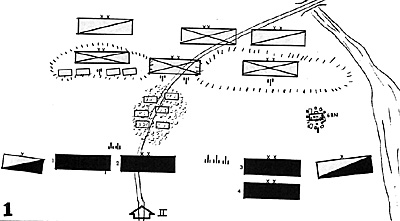 The battlefield was as shown in Map 1. The Austrian corps was formed in line of battle along the summit of a line of gentle heights through which the main road passed, and had forward posts in the woods and the village, each occupied by 6 battalions of light troops. The Austrian corps comprised 4 infantry and 2 cavalry divisions (28,800 infantry and 3,600 cavalry) together with 40 guns. The French force consisted initially of 1 corps, comprising 4 infantry and 1 cavalry divisions (19,200 infantry and 2,000 cavalry) plus 46 guns.
The battlefield was as shown in Map 1. The Austrian corps was formed in line of battle along the summit of a line of gentle heights through which the main road passed, and had forward posts in the woods and the village, each occupied by 6 battalions of light troops. The Austrian corps comprised 4 infantry and 2 cavalry divisions (28,800 infantry and 3,600 cavalry) together with 40 guns. The French force consisted initially of 1 corps, comprising 4 infantry and 1 cavalry divisions (19,200 infantry and 2,000 cavalry) plus 46 guns.
Later in the day the arrival of the second corps would bring this force to a total of some 30,000 infantry and 3,500 cavalry with 90 guns, however the Emperor, once he had realised that the Austrian army might escape his trap, had sent a peremptory order to the commander of the French force to attack immediately he arrived with whatever force was available.
THE OPENING MOVES
The battle opened at 11:15 in the morning. Prior to this the arrival of the French and their deployment, which was uninterrupted by their opponents except for some artillery fire, had been dialogued by the players in a few minutes. The French battle plan merely called for an assault on the enemy's right by the 1st division, preceded in echelon by the 2nd division, ordered to clear the woods then assault the enemy covering the road. The 3rd and 4th divisions were ordered to march on the heights occupied by the enemy's left. The caval ry was to move forward in line with the infantry and to engage the enemy's cavalry if it ventured out to attack the infantry.
The French batteries, owing to the difference in elevation between their positions and those of the enemy's troops, could only engage the latter from long range. Two divisional batteries and the corps heavy battery were grouped on the right of the road to engage the enemy's left, the other two divisional batteries being posted on the left of the road to fire on the enemy's right. The artillery had come into action as soon as it had deployed but its effect had been minimal owing to the range and elevation.
The advance of the French forces was dialogued by the players and, after determining that the leading brigade of the 2nd division would cause the first game interruption as it came within morale test distance of the wood, they employed the dislocation procedure to bring forward the movements of the other parts of the corps. With the exception of the 2nd brigade of the 2nd division, whose progress depended on the outcome of the struggle for the woods, the remaining movements of the corps could all be "dislocated." The result of this is shown in Map 2.
THE FIRST ATTACKS
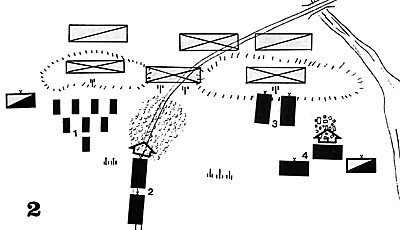 The 1st French division, formed in two lines of
battalion columns with one battalion in reserve, was
launched directly against the enemy's right. The two sides
ended up in a fire-fight, during which both suffered
severely, but which resulted in the French troops
streaming back down the slopes, only to rally some 500
yards behind their starting positions. The French cavalry
brigade commander, seeing the rout of the infantry, drew
back by stages, retiring his lines alternately so as to cover
the infantry against the possibility of attack by Austrian forces.
The 1st French division, formed in two lines of
battalion columns with one battalion in reserve, was
launched directly against the enemy's right. The two sides
ended up in a fire-fight, during which both suffered
severely, but which resulted in the French troops
streaming back down the slopes, only to rally some 500
yards behind their starting positions. The French cavalry
brigade commander, seeing the rout of the infantry, drew
back by stages, retiring his lines alternately so as to cover
the infantry against the possibility of attack by Austrian forces.
The 2nd French division, drawn up in two columns by brigades, one behind the other, moved into the woods. Although outnumbered, the Austrians put up a stout defense, and it was only after heavy loss on both sides that the French eventually retained possession of the woods, having taken 45 minutes to capture it. The remnants of the Austrian force fell back behind their main line of battle, where they rallied.
The 3rd division, deployed in two brigade columns side by side, marched past the village and onto the heights, leaving the 4th division, which had marched to its left into echelon with the 3rd, to attack the village. The 3rd lost the engagement and streamed back towards their first positions but the affair had been far closer than that involving the 1st division, and the Austrian brigade in first line had been virtually destroyed.
The divisional commander, realizing that another attack would crush his first line, changed his lines over (placing the units of his second line on the ground previously occupied by the first line) and sent off a message for assistance to the corps commander.
The 4th French division commander underestimated the numbers of the enemy in the village and only ordered one brigade into it. Although it fought well, this brigade was beaten off with a fair number of casualties. Before the divisional commander could bring his 2nd brigade into action, the rout of the 3rd division saw its soldiers streaming down the slopes and into his reserve, disrupting them and, as far as he knew, placing it in danger of attack from the Austrians. Therefore he restored order among his forces and held his position. The French cavalry brigade on the right of the 4th division remained in position.
The French commander, seeing the failure of his attacks, sent orders to the 2nd division's commander to hold his position in the woods and not continue with his advance. He then set out to renew his assault on the enemy, but this time with a far more careful preparation. It was obvious that his forces could not be ready to renew their attacks for some time (it was now almost 1pm), so he set the time for his second wave of attacks for 2.30pm.
By this time he expected that the 2nd corps d'armee would be well up the road, and he sent an urgent request to its commander for permission to use his leading division of infantry and his cavalry division.
The commander of the 2nd corps, more than a little wary of his colleague's battle-handling skill, agreed that his leading divisions could be employed, but only in support of those of the other corps. To ensure that this was observed, he issued orders directly to his divisional commanders not to engage the enemy unless they were acting in support of already engaged divisions of the other corps.
The commander of the 1st French corps determined on a major attack against the enemy left. The 1st division was once again to attack the enemy's right. This time, however, the cavalry brigade on its flank was ordered to sweep round the enemy's flank and attack the cavalry beyond, its attack to coincide with that of the 1st division. The 2nd division was to form up on the road through the wood, which it currently occupied, and was to cover its exit by throwing forward a strong screen of light troops. The 3rd division was to resume its attack on the enemy's left, with a coincidental advance of the cavalry brigade, which had been brought across from its right to a position on the right of the road, across the edge of the high ground and onto the enemy cavalry. The 4th division was to assault the village once more, and the cavalry and infantry divisions from the 2nd corps d'armee were to march for the bridge-and establish a position there, cutting the enemy off from both reinforcement and retreat by that route.
The Austrian commander knew that his left was his weak point and that possession of the bridge or of the high ground on which his left stood, would permit the enemy to prevent his passage across the river; there was insufficient room for the French to bring against his left all of the forces that they were deploying in that direction. This could only mean that they intended to pass his flank, relying on the arrival of the forces he could see moving down the road in the distance to press home any of their attacks against his line that were repulsed.
To complicate matters, the Austrian commander had just received orders from his commander requiring that the French be held up for as long as possible.
Feeling that he could rely on the spirit of his officers and soldiers, and realising that there was little he could do against the forces which appeared to be coming to join the French, he ordered his reserve division to his left flank to block the anticipated French movements, and sent a message to his other commanders calling on them to fight to the death.
THE FRENCH RENEW THE ATTACK
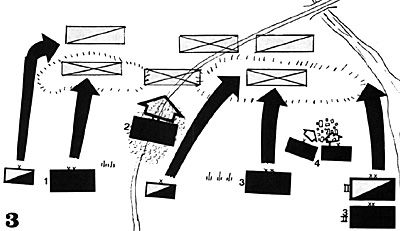 At 2.30pm the renewed French attacks started. The
Players dialogued the major movements of the forces and,
since the outcome of the fight between the 2nd division
and its Austrian opponents would not affect either of the
movements on its flanks, these were dislocated forwards.
Similarly, the attacks of the 3rd and 4th divisions would
not affect one another, or the movement of the divisions of
the 2nd corps, and these too were dislocated from one
another, the game being progressed as shown in Map 3.
At 2.30pm the renewed French attacks started. The
Players dialogued the major movements of the forces and,
since the outcome of the fight between the 2nd division
and its Austrian opponents would not affect either of the
movements on its flanks, these were dislocated forwards.
Similarly, the attacks of the 3rd and 4th divisions would
not affect one another, or the movement of the divisions of
the 2nd corps, and these too were dislocated from one
another, the game being progressed as shown in Map 3.
The French 2nd division, having sent forward two battalions in skirmish order to keep the enemy busy while the remainder of the division marched clear of the wood and formed line of battle, was given no time to develop its movement. The commander of the Austrian division opposed to the wood, on seeing the leading French battalion begin to emerge from the wood, ordered his line to advance. Faced with a solid wall of resolute infantry advancing on them the French skirmishers beat a hasty retreat, exposing their comrades in the leading battalions.
These units, outfaced by this unexpected action, came to a halt and started to fire indiscriminately on the enemy. The Austrians, unperturbed by the desultory fire of the enemy, continued their forward movement until, when the Austrians came to a distance of only 50 yards, the French broke and fled back into the wood in disorder. At this, the Austrian commander halted his division and marched it back to its original position.
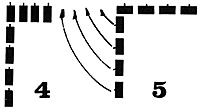 On the French left, greater success was being
achieved. Learning from his earlier mistakes, the French
divisional commander deployed his two brigades in an 'L'
shape (Map 4). In close columns his force advanced to
some 200 yards of the enemy, at which point the leading
brigade deployed into line and opened fire on the
Austrians. The Austrian commander was somewhat
baffled since from that distance the French would be
unable to do much damage. However, shortly after the
French had disappeared in the smoke generated by their
fire, he suddenly saw what the other commander was up to.
On the French left, greater success was being
achieved. Learning from his earlier mistakes, the French
divisional commander deployed his two brigades in an 'L'
shape (Map 4). In close columns his force advanced to
some 200 yards of the enemy, at which point the leading
brigade deployed into line and opened fire on the
Austrians. The Austrian commander was somewhat
baffled since from that distance the French would be
unable to do much damage. However, shortly after the
French had disappeared in the smoke generated by their
fire, he suddenly saw what the other commander was up to.
On the left of the first French brigade, the second had started to deploy into a line of battalion columns (Map 5), extending the French line beyond that of the Austrians. To counter what appeared to be an imminent assault on his right flank, the Austrian commander, leaving his first line to continue the action against the French 1st brigade, ordered his second to change front to the rear on its left flank and then to advance until its left was on the right of the first line (Map 6).
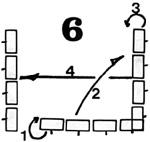 Unfortunately, by the time he had become aware of
the French manuever and his troops had started to react
to his orders, the French 2nd brigade had already
deployed and changed front obliquely in columns to the
right so that it was now directed at the flank of the
Austrian division. Before the Austrian second line could
get under way, the French were already advancing,
supported by the ist brigade, which had stopped firing and
resumed its advance against the front of the Austrian
division. Attacked in front and flank, the Austrian infantry
broke and fled, making off in the direction of the bridge.
Unfortunately, by the time he had become aware of
the French manuever and his troops had started to react
to his orders, the French 2nd brigade had already
deployed and changed front obliquely in columns to the
right so that it was now directed at the flank of the
Austrian division. Before the Austrian second line could
get under way, the French were already advancing,
supported by the ist brigade, which had stopped firing and
resumed its advance against the front of the Austrian
division. Attacked in front and flank, the Austrian infantry
broke and fled, making off in the direction of the bridge.
The Austrian cavalry had been posted behind the infantry so as to be in position to counter-attack the French cavalry as it passed through the line of battle, but the French cavalry had been ordered to by-pass the enemy infantry and attack their cavalry. The Austrian commander of the cavalry division had positioned himself on the ridge where the infantry was posted
As a result of his good positioning, the commander of the Austrian cavalry was able to ride back to his division and have his brigades change front obliquely to the left so that, when the French cavalry came round the side of the ridge, instead of coming onto the flank of the Austrian cavalry, they came head-on into its leading brigade, the second brigade being formed behind the first. The French cavalry could make no headway against the superior Austrian force, but had prevented it from interfering in the engagement on the ridge. Beaten back, the French cavalry was able to rally a short distance from the ridge. The Austrian commander saw no sense in pursuing it after his infantry colleague had already lost his ground.
In the center, the 2nd French division, each time that it tried to emerge from the wood, was counter-attacked by the Austrian division opposed to it and compelled to retire back into the wood. Seeing his colleague overthrown on his left, however, the commander of the Austrian division realised that he too would have to retire. Before the French could re-group and attack his flank, therefore, he ordered a retirement 'en exchequer' (having the odd-numbered battalions fall back 100 yards, followed by the even- numbered battalions), and withdrew to take up a position at an oblique angle to the division on his left.
Realising what his French opponents intended, the Austrian cavalry commander ordered his brigades to move forward into the intervals between the infantry divisions. By this movement, he limited the front on which the enemy cavalry commanders could engage him, thus reducing their numerical advantage at the point of contact. By a superb piece of timing, bringing his cavalry on top of the heights just as the French were riding up them, he also gained the advantage of ground.
The French cavalry had advanced by brigades, intending to form divisional lines on passing through the enemy line of battle. As the Austrian cavalry poured over the high ground it struck the leading brigades of the French divisions and, since these had been too closely deployed, threw them back onto their second brigades, disordering these in the process. The Austrian cavalry, however, over-reacted to their victory and ploughed on after the French for some 500 yards before they could be brought back under orders.
Meanwhile, the 3rd and 4th French divisions launched their assaults. The 3rd division, formed into two brigade mixed orders (two battalions in line flanked by one in column on either side), marched resolutely towards the Austrian left. However, instead of the already-reduced battalions that they had expected to find, the French were met by the units that had previously occupied the Austrian division's second line.
Both of these divisions, composed of veteran troops who had seen service on many battlefields, were keen to come to grips with their opponents and to settle the matter without hesitation. As the French came within 200 yards of the Austrians, who had been deployed back from the crest of the ridge in order to further reduce the effects of artillery fire, the Austrian commander was heard to mutter 'Now we'll see my lads' (in German, of course) and ordered his line to advance.
Both sides crossed the interval between them at the charge step. In less than a minute they were within 50 yards of one another. Neither would give way. Impressed by the bold appearance of their opponents, both sides halted and opened fire to drive the other away. At 50 yards even the much-maligned musket could be deadly against massed targets. In a very few minutes both sides had suffered tremendous casualties, but the gallant Austrians, out-numbered by their opponents, found it impossible to sustain the casualties and broke.
The sacrifice of the Austrian first line units had not been in vain, however. All of the French force had been committed to the fire-right and, although victorious, would still take a few minutes to reorganize itself before it could continue its advance. As he had ordered his first line forward, the Austrian commander had ordered his second line units to form columns. As his first line units fled back through the intervals between the columns of his second line, the Austrian commander ordered the latter to advance against the French.
The French commander, who had only just, or so it appeared, snatched the victory from his opponent in an extremely hard-fought contest, saw his victory taken from him by the arrival of the Austrian second line. His troops, still shaken and disorganised from their firefight with the Austrian first line, broke and fled at the sight of fresh Austrian units -coming towards them. Owing to their deep formations, the French units in column could not break free for a few minutes after the initial shock set in, with the result that the Austrians were upon them, killing several and capturing many of the French soldiers.
The French 4th division had been heavily engaged in the village. This time, however, the already-depleted Austrian battalions were opposed by the entire French division and, although they put up a heroic resistance, the French eventually dislodged them. They did not do so, however, in time to be of any assistance to their colleagues in the 3rd division, and as the Austrian cavalry was still in the area, the French commander felt it more prudent to keep his troops within the safety of the buildings.
The division of the 2nd French corps, moving against the extreme left of the Austrian position, had more success than those on its left. The repulse of the French cavalry might have brought its movement to a halt if it had not been for the Austrian cavalry over-reacting and chasing after its defeated French opponents. This gave the division, deployed in two lines of close unit columns, time to come up to its Austrian opponents.
The Austrian corps commander had employed his seasoned troops in his front line, and had kept in reserve a division of conscripts who had seen little action. It was this division which he had been forced to send to his extreme left in an attempt to avert the danger of the French securing a hold on the bridge in his rear. The conscripts, however, proved no match for the French veterans. The latter, in a well-orchestrated attack, launched themselves against the Austrian lines.
The leading French brigade became shaken when it was with in 50 yards of the enemy, who had opened up a rapid, if individual fire. The French commander however, himself an experienced veteran, had deployed his second brigade 150 yards behind the first. with its battalions in the intervals between those of the first brigade, over-lapping them on the right. This prevented them from being disordered by the engagement of the first brigade and permitted him to throw them at the enemy through the intervals in the first line.
The arrival of these battalions overthrew the Austrian infantry, whose commander had brought his second line up immediately behind his first to strengthen it. Within minutes, the Austrians were fleeing for the safety of the bridge.
As soon as the Austrian cavalry started to make its way back towards its last position on the heights, the French commander ordered his battalions into squares. The change of formation, since they were in close columns, took less than a minute and the Austrian cavalry commander, realising that he could do nothing against the infantry, merely brought his cavalry brigade back onto the heights, on the left of the infantry, and deployed it to face the flank of the French righthand division.
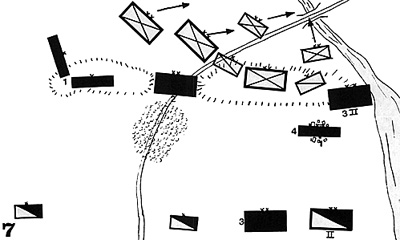 The position after the second wave of French attacks
was as shown in Map 7. Although the French had gained
ground on the left, and appeared to be in a stronger
position than the Austrians, this was illusory. All of the
French cavalry was still rallying some distance from the
field, and there was none available to counter that of the
enemy. The Austrians, however, did not retain enough
strength to regain the positions they had lost, and their
commander realised that the only course open to him if he
wished to save his corps was to effect a retreat before the
French could resume the offensive.
The position after the second wave of French attacks
was as shown in Map 7. Although the French had gained
ground on the left, and appeared to be in a stronger
position than the Austrians, this was illusory. All of the
French cavalry was still rallying some distance from the
field, and there was none available to counter that of the
enemy. The Austrians, however, did not retain enough
strength to regain the positions they had lost, and their
commander realised that the only course open to him if he
wished to save his corps was to effect a retreat before the
French could resume the offensive.
The Austrian commander issued his orders for the retreat of the corps at 4pm and with the cavalry covering their withdrawal, the infantry divisions marched to the road and then down it and across the bridge. The Austrian cavalry retired by regiments alternately keeping just far enough ahead of the French infantry divisions to compel them to form squares in case they attacked. The French cavalry began to arrive back on the battlefield just as the last of the Austrian infantry were passing over the bridge and so the battle ended.
CRITIQUE
The game, which lasted for 1 and 1/2 hours of player time provided both commanders with some interesting problems. The Austrian commander, even though he had superior numbers at the start, knew that there were other French forces en route to the battlefield. His major problem was that most delicate of military operations a withdrawal in the face of an enemy who was in a position to attack him. The French commander was faced with the problem of being required by his orders to fight an enemy who not only out-numbered him but stood in a good defensive position.
The Austrian, since it was obvious that his left was his weakest flank, might have been better advised to have held his right and center with one division, by placing a brigade on the heights and one behind the wood. This would have permitted him to hold a second division, of veteran troops, in reserve behind his left. If pressed on his right he could have given ground on that flank while still covering the bridge which formed his line of retreat. He might also have done better to deploy his cavalry by brigades, since he was fortunate in his cavalry commanders, who could be expected to fight aggressively against the superior numbers of the French.
The Emperor's orders to attack the enemy immediately were too literally interpreted by the French commander. His urgency to comply with those orders communicated itself to his divisional commanders, who assaulted the enemy with no degree of finesse. With classic simplicity the French divisions rushed at their opponents, and with classic simplicity they were thrown back. That the French commanders realised this is evident from the greater care which they bestowed on their tactical planning in the second wave of attacks.
The French cavalry commanders were unfortunate in that, had they been faced with commanders of lesser ability than those they did face, they might have carried the day. Had this occurred, the Austrian position would have been serious, and it is unlikely that they could have escaped serious defeat. in the event, however, the French cavalry was not well handled, too many being committed at once in situations which did not give it the ability to exploit its numerical superiority that victory required. It was this factor alone which gave the Austrian commander the opportunity--which he exploited to the full-to withdraw his force safely.
Back to Table of Contents -- Courier Vol. IV #1
To Courier List of Issues
To MagWeb Master Magazine List
© Copyright 1982 by The Courier Publishing Company.
This article appears in MagWeb (Magazine Web) on the Internet World Wide Web.
Other military history articles and gaming articles are available at http://www.magweb.com